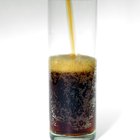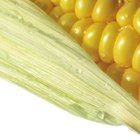Primarily known for its integral role in the production of tequila, agave juice is becoming popular in Western kitchens for its healthy properties as a diet food and a natural sweetener. Made from the core of the agave plant, agave juice--which is poisonous when raw--is processed by heat and enzymes into agave nectar.
Background
The many varieties of the agave plant primarily grow in Mexico and tropical South America, although some varieties grow in the southwestern United States, where the sap of the agave plant was also known to indigenous and traditional Mexican societies as aguamiel, or “honey water.” Related to the amaryllis and lily families, agave plants are also known as the “century plant,” because of the amount of time it takes to mature.
Processing
Agave juice is harvested and compressed like fruit from the core of the agave, known in Spanish as the “pina” because of its pineapple-like texture. From there, the filtered agave juice is heated to break down the carbohydrates, according to chefs Aki Kamozawa and H. Alexander Talbot, co-owners of Ideas in Food, a New York City-based consulting business.
Finally, enzymes and hydrolysis convert the raw juice into a viscous nectar. The chefs, who have worked in restaurants in Boston and New York City and currently work with restaurants and caterers to encourage the use of "sustainable, organic and artisanal food products," say that different species of agave lend nectars with different flavors and colors--light, amber and dark.
Healthy Alternative
Many people have made the switch from sugar to agave nectar, including sugar-sensitive diabetics and dieters. Because agave nectar is mostly fructose--a natural sugar found in fruit--and not glucose, it can be used with few side effects by diabetics. Dieters also can enjoy agave nectar, because it has fewer calories than sugar or honey and packs a similar punch. Vegans and vegetarians cook with agave nectar. It is a plant product and is less processed than refined cane sugar. Agave nectar can replace sugar in hot and cold drinks, baking and other recipes. To cook with any of these, VegFamily Magazine recommends that you use 2/3 to 3/4 the amount of sugar called for in the recipe and to reduce the amount of other liquid in the recipe by 25 percent. Kamozawa and Talbot recommend that home chefs use light versions for delicately flavored dishes and darker versions for recipes that call for corn syrup, maple or molasses. Most agave syrups are available in the United States are organic, vegan and kosher.
Traditional drinks
Agave azul, or “blue agave,” is often distilled into juice and turned into tequila. By Mexican law, liquours called “tequila” must be manufactured from the blue agave plant in Jalisco, Guanajuato, Michoacan, Nayarit or Tamaulipas provinces, and 100 percent of the drink must be pure fermented agave juice. Mixto tequila, often sold alongside true tequila, includes unfermented, processed agave juice. Agave juice is also one of the major ingredients in the Mexican beverage pulque, a traditional alcoholic beverage made from fermented juice of the maguey agave plant. Another drink, called mezcal, is also made from the maguey, but through a different process. Chefs Talbot and Kamozawa also recommend that bartenders use agave nectar in cold drinks, as it dissolves easily and requires less stirring.
Warnings
Despite its healthy adaptations, some chefs and nutritionists advise consumers not to rely heavily on agave nectar in their coffee, tea or cookies. Fructose is metabolized in the liver, so, like the high-fructose corn syrup found in many modern foods, agave nectar could prove dangerous if large amounts are eaten at once or relied on completely as a sweetener. Agave nectar can also cause severe dermatitis--swelling, itching, and rash--in those who are allergic to it.
Related Articles

How to Make Carob Juice

What Is Agave Syrup?

How to Extract Fructose From Plants

How to Bake With Erythritol

Baking With Juice Concentrates

Uses of Sorghum

The Difference Between Fruit Juice & ...

Is Wheat Grass an Alkalizing Food?

What Can I Substitute for Malt Extract?

Is There Glucose in Soda?

Where to Buy Pomegranate Juice

How to Eat Buckwheat Raw
Ways to Make Tomato Juice Taste Better

What Causes Honey to Ferment?

How to Make Soursop Juice

What Liquors Are Made From Sugar Cane?

List of Foods Imported to Britain

Substitutes For Tequila

How to Substitute Light Corn Syrup in a ...

Gluten-Free Energy Drinks
References
Writer Bio
Catherine Oz has been a journalist and writer since 2000. A former staff writer for newspapers in New York and Florida, she has also published fiction in small journals such as "Elbowroom" and "Aoife's Kiss." Oz holds a B.A. in English.